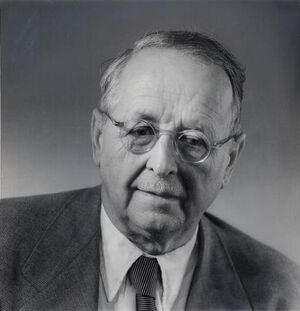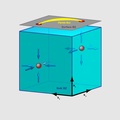Hermann Weyl (nonfiction)
Hermann Klaus Hugo Weyl, ForMemRS (German: [vaɪl]; 9 November 1885 – 8 December 1955) was a German mathematician, theoretical physicist, and philosopher.
Although much of his working life was spent in Zürich, Switzerland and then Princeton, he is associated with the University of Göttingen tradition of mathematics, represented by David Hilbert and Hermann Minkowski.
His research has had major significance for theoretical physics as well as purely mathematical disciplines including number theory. He was one of the most influential mathematicians of the twentieth century, and an important member of the Institute for Advanced Study during its early years.
Weyl published technical and some general works on space, time, matter, philosophy, logic, symmetry and the history of mathematics. He was one of the first to conceive of combining general relativity with the laws of electromagnetism.
While no mathematician of his generation aspired to the 'universalism' of Henri Poincaré or David Hilbert, Weyl came as close as anyone. Michael Atiyah, in particular, has commented that whenever he examined a mathematical topic, he found that Weyl had preceded him.
In 1911 Weyl published Über die asymptotische Verteilung der Eigenwerte (On the asymptotic distribution of eigenvalues) in which he proved that the eigenvalues of the Laplacian in the compact domain are distributed according to the so-called Weyl law. In 1912 he suggested a new proof, based on variational principles. Weyl returned to this topic several times, considered elasticity system and formulated the Weyl conjecture. These works started an important domain—asymptotic distribution of eigenvalues—of modern analysis.
In 1913, Weyl published Die Idee der Riemannschen Fläche (The Concept of a Riemann Surface), which gave a unified treatment of Riemann surfaces. In it Weyl utilized point set topology, in order to make Riemann surface theory more rigorous, a model followed in later work on manifolds. He absorbed L. E. J. Brouwer's early work in topology for this purpose.
In 1918, he introduced the notion of gauge, and gave the first example of what is now known as a gauge theory. Weyl's gauge theory was an unsuccessful attempt to model the electromagnetic field and the gravitational field as geometrical properties of spacetime. The Weyl tensor in Riemannian geometry is of major importance in understanding the nature of conformal geometry. In 1929, Weyl introduced the concept of the vierbein into general relativity.
His overall approach in physics was based on the phenomenological philosophy of Edmund Husserl.
From 1923 to 1938, Weyl developed the theory of compact groups, in terms of matrix representations. In the compact Lie group case he proved a fundamental character formula. These results are foundational in understanding the symmetry structure of quantum mechanics, which he put on a group-theoretic basis.
Weyl also showed how to use exponential sums in diophantine approximation, with his criterion for uniform distribution mod 1, which was a fundamental step in analytic number theory. This work applied to the Riemann zeta function, as well as additive number theory.
In 1929, Weyl proposed a fermion for use in a replacement theory for relativity. This fermion would be a massless quasiparticle and carry electric charge. An electron could be split into two Weyl fermions or formed from two Weyl fermions. Neutrinos were once thought to be Weyl fermions, but they are now known to have mass. Weyl fermions are sought after for electronics applications to solve some problems that electrons present. Such quasiparticles were discovered in 2015, in a form of crystals known as Weyl semimetals, a type of topological material.
In The Continuum Weyl developed the logic of predicative analysis using the lower levels of Bertrand Russell's ramified theory of types. He was able to develop most of classical calculus, while using neither the axiom of choice nor proof by contradiction, and avoiding Georg Cantor's infinite sets. Weyl appealed in this period to the radical constructivism of the German romantic, subjective idealist Fichte.
Shortly after publishing The Continuum Weyl briefly shifted his position wholly to the intuitionism of Brouwer. In The Continuum, the constructible points exist as discrete entities. Weyl wanted a continuum that was not an aggregate of points. He wrote a controversial article proclaiming that, for himself and L. E. J. Brouwer, "We are the revolution." This article was far more influential in propagating intuitionistic views than the original works of Brouwer himself.
George Pólya and Weyl, during a mathematicians' gathering in Zürich (9 February 1918), made a bet concerning the future direction of mathematics. Weyl predicted that in the subsequent 20 years, mathematicians would come to realize the total vagueness of notions such as real numbers, sets, and countability, and moreover, that asking about the truth or falsity of the least upper bound property of the real numbers was as meaningful as asking about truth of the basic assertions of Hegel on the philosophy of nature. Any answer to such a question would be unverifiable, unrelated to experience, and therefore senseless.
However, within a few years Weyl decided that Brouwer's intuitionism did put too great restrictions on mathematics, as critics had always said. The "Crisis" article had disturbed Weyl's formalist teacher Hilbert, but later in the 1920s Weyl partially reconciled his position with that of Hilbert.
After about 1928 Weyl had apparently decided that mathematical intuitionism was not compatible with his enthusiasm for the phenomenological philosophy of Husserl, as he had apparently earlier thought. In the last decades of his life Weyl emphasized mathematics as "symbolic construction" and moved to a position closer not only to Hilbert but to that of Ernst Cassirer. Weyl however rarely refers to Cassirer, and wrote only brief articles and passages articulating this position.
By 1949, Weyl was thoroughly disillusioned with the ultimate value of intuitionism, and wrote: "Mathematics with Brouwer gains its highest intuitive clarity. He succeeds in developing the beginnings of analysis in a natural manner, all the time preserving the contact with intuition much more closely than had been done before. It cannot be denied, however, that in advancing to higher and more general theories the inapplicability of the simple laws of classical logic eventually results in an almost unbearable awkwardness. And the mathematician watches with pain the greater part of his towering edifice which he believed to be built of concrete blocks dissolve into mist before his eyes."
In the News
2017: First use of Weyl semimetal crystals to detect crimes against mathematical constants.
Fiction cross-reference
Nonfiction cross-reference
- David Hilbert (nonfiction)
- Edmund Husserl (nonfiction)
- Georg Cantor (nonfiction)
- George Pólya (nonfiction)
- Hermann Minkowski (nonfiction)
- L. E. J. Brouwer (nonfiction)
- [[Marius Sophus Lie (nonfiction)]
- Mathematician (nonfiction)
- Henri Poincaré (nonfiction)
- Weyl semimetal (nonfiction)
External links:
- Hermann Weyl @ Wikipedia

